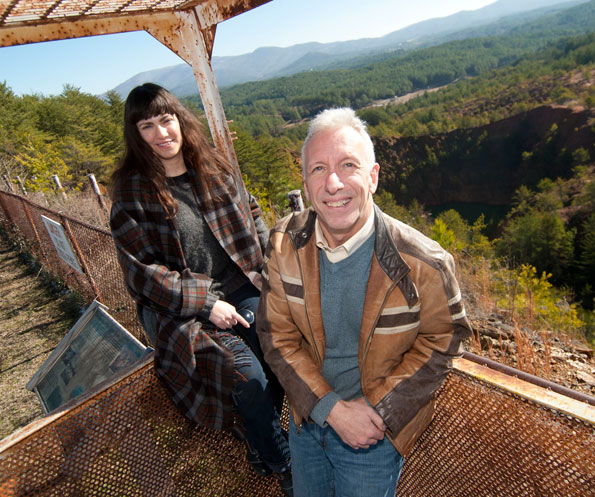
Dr. Will Simson and GPC Library Information Science Technology (LIST) student Victoria Nicholson are exploring historic records from a defunct copper mine in Tennessee’s mountains. (Photo by Bill Roa.)
GPC Student and Professor Lend Skills to Tennessee Copper Mine Project
by Rebecca Rakoczy
There is a deep hole in Ducktown, Tenn.—a great sinkhole caused by the collapse of abandoned copper mine shafts in these mountainous hills. Trees have sprouted on what was once raw red clay, and deep within the abyss, a subterranean lake sparkles in the morning sun.
It’s here, in this rugged, but beautiful environment near the Cherokee National Forest, that Georgia Perimeter College student Victoria Nicholson comes to work twice a month along with history professor William Simson.
Nicholson isn’t a geology student studying the rocky land—she’s enrolled in GPC’s Library and Information Science Technology (LIST) program. As an intern, she’s working at the Ducktown Basin Museum, which overlooks the defunct Burra Burra Copper Mine in Tennessee, just north of the Georgia state line. She’s helping to research and archive thousands of records as part of a memorial project for the museum.
The small museum perches at the top of a mountain, its artifacts and displays documenting the lives and livelihood of tens of thousands of men and women who worked in what was once believed to be the largest copper ore find in the Western Hemisphere. In addition to copper, the mine produced oleum, an extremely powerful sulfuric acid used in munitions for drying gun powder. At one point, the plant became the No. 1 sulfuric acid plant in the world.
The mine operated from the mid-1800s to the 1960s, and when the mining operation finally closed in 1987, the former Tennessee Copper Mining Company turned its records over to the museum, says Ken Rush, the museum director.
For Nicholson, the opportunity to work with the museum is a dream come true. “I always wanted to be an archivist,” she says. The project is a collaboration between professor Simson and Dr. Stephen Koplan, coordinator of Georgia Perimeter’s LIST program, and the Ducktown Basin Museum.
Simson has long been familiar with the Ducktown area. His first visits were three decades ago, and the mine later served as the basis of his doctoral thesis, which focused on the region’s labor relations at the mines, smelters, and chemical works through World War II.
“When I first came to this area in the 1980s, there were almost no trees; no grass, no plants,” Simson recalls. “Years of mining and producing the highly toxic (sulfuric) acid had rendered the area sterile—nothing would grow. Heavy metals, like iron, zinc, copper, aluminum and manganese flowed into the nearby Ocoee River, dumping the equivalent of the metal of one to two autos a month into the water.”
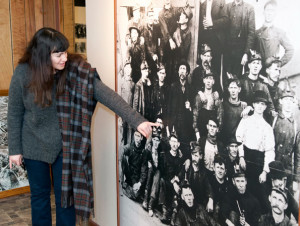
Inside the Ducktown Basin Museum, GPC student Victoria Nicholson stands by a giant photograph of miners taken in the early 20th century. She notes the open flame lanterns used by the miners. (Photo by Bill Roa)
The devastated landscape didn’t bother the populace of the early 20th century, he says. Sulfur was thought to have a curative effect for health problems, and hotels sprung up around the Copper Basin for those seeking its “healing” powers.
With permission from the museum’s director, Ken Rush, and its board of directors, Simson had already begun the tedious task of going through the files, which document the accidents, industrial management decisions, labor relations and the daily life of the miners.
When Simson first began his research of the mine records, he couldn’t believe his eyes. “I came back to school (GPC), and I was bouncing off the walls. For historians to come across something like this is incredible. These records are important to medical historians, public official historians—you name it. These (particular) records (that Nicholson is cataloguing) show how law firms of the day interacted with private individuals and industrial corporations. Every box is a treasure.”
When Simson shared with Koplan that the museum needed help cataloguing its files, the LIST coordinator knew he had a student who would be perfect for the job. Nicholson jumped at the chance. “I was so excited to get this project. This is amazing, nothing has been done, sorted or dated; nothing has been archived electronically.”
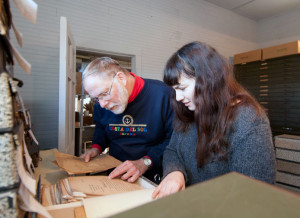
Dr. Steve Koplan, coordinator of GPC’s Library and Information Science Technology (LIST) program, left, and LIST student Victoria Nicholson review fatality and accident reports of the Tennessee Copper Company. (Photo by Bill Roa)
Nicholson chose Georgia Perimeter College because of its LIST program. “Not many colleges offer library science. I read a lot and like history,” making the archival project a good match for her abilities, she says. Her LIST classes are online, but this project offered a unique opportunity to put her studies into action, she says.
Koplan, who oversees Nicholson’s work as an intern, is always looking for non-traditional sites for his students and has placed interns at locations as diverse as hospitals and facilities for disabled individuals, trying to match his students’ interests with the market demands, he says.
Twice a month, Nicholson and Simson bring their laptops to what was once the mine workers’ payroll office. It’s a simple clapboard frame building filled floor-to-ceiling with file cabinets, old hospital equipment (the mine operated a hospital for its workers and families) and tools. The cabinets hold more than a century of records—from the accident reports to the blueprints of the mines, even to the newsletters printed in the 1940s by striking miners.
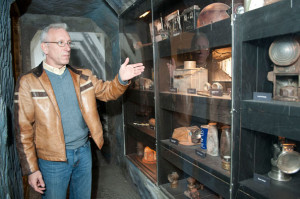
Dr. Will Simson explains museum exhibits displaying tools and articles used by the copper miners. (Photo by Bill Roa)
Currently, Nicholson’s part of the project involves typing all the information from the accident and death reports into a central database she is creating for the museum. As an example, she pulls out one paper file detailing the case of two men who improperly opened a train car tanker that held sulfuric acid. Kept in a pressurized environment, the acid “exploded” onto the men. The resulting burns described in the report were horrendous—and so are the photos, tucked in the report folder in a simple brown envelope.
This human trauma—and other reports, which detail injuries, deaths or the lung disease caused by breathing the silica-laced air in the mine tunnels—are recorded in hundreds of court affidavits and hospital reports. Each document reveals how the worker (or his family) was treated by the mine company and its hospital staff, if he came back to work, and if he was compensated for lost time. (The men who were burned by the sulfuric acid lost their legal claim; they were found not to have followed directions on how to open the tanker, says Nicholson. One man eventually died as a result of his injuries).
By the end of spring semester, Nicholson and Simson hope to have a verified record of all the men who perished in the mine, creating a searchable database for the museum’s memorial project.
Despite what these reports show, “the good news is, we’ve found that this was a relatively progressive management team as early as the 1920s,” says Simson. “They took good care of their workers, at least by the standards of the time. Samuel A. Lewisohn, who owned the mine, was a pioneer in industrial employee relations—he was a consultant to FDR (President Franklin Delano Roosevelt) and helped craft what is now our Social Security system.”
Years before, the formation of today’s federal environmental laws began in the Copper Basin, which straddles the tristate area of Georgia, Tennessee and western North Carolina. “Thousands of tons of earth had to be shipped away because it was so toxic,” Simson says. The lawsuits Victoria is researching began in the early part of the 20th century.
Museum director Rush lauds the work of Nicholson and Simson. “We do not have the manpower to do this on our own,” he says. “They have taken this to another level—it’s invaluable to us.”
While LIST internships usually last only one semester, Nicholson, who started her project in the fall of 2012, is continuing this year in an attempt to set up a more complete database, says Koplan. Her role in the project will end in May when she graduates from GPC.
In the fall, Simson hopes to bring some of his history students to the museum to help catalogue the mine’s labor relations records, letting them do their term papers on their work.
“Victoria is laying the groundwork for the systems we can use to archive all this information,” Simson says. “She is invaluable to the project and can recommend best practices for dealing with the vast amount of material being reviewed.”
For more information about the Burra Burra Copper Mine, visit the Ducktown Basin Museum website. For information about the LIST program, visit the program’s web page or contact Koplan at 770-274-5088. For additional information on the project, contact Simson at 770-274-5469.


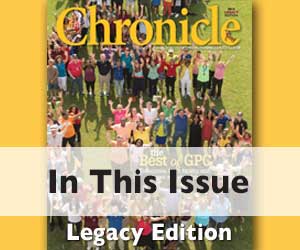
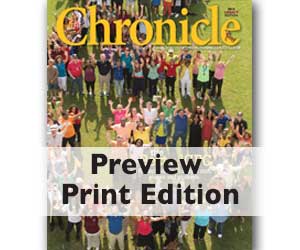
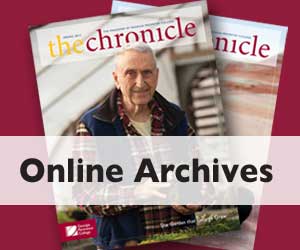


Digging through Data (Video) | GPC The Chronicle on April 13, 2013 at 11:28 am.
[…] There is a deep hole in Ducktown, Tenn.—a great sinkhole caused by the collapse of abandoned copper mine shafts in these mountainous hills. It’s here, in this rugged, but beautiful environment near the Cherokee National Forest, that Georgia Perimeter College student Victoria Nicholson comes to work twice a month along with history professor William Simson. See article. […]
Alice Murray on April 30, 2013 at 1:40 pm.
The history of mining in the Ducktown, Copperhill area of the Tennessee mountains is fascinating. As a child, I often visited my grandparents in nearby Cleveland, Tennessee, and we would drive up U.S. 64 to see the mine site. In those days, it looked like a moonscape, with absolutely no vegetation. It’s encouraging that today the area is covered with green vegetation and looks less toxic.
In the 1990s, my mother wrote a history of the Bradley County (Cleveland), Tennessee area, and I learned that the mine supplied most of the copper for the Confederate Army during the Civil War.